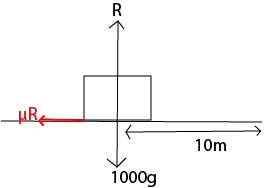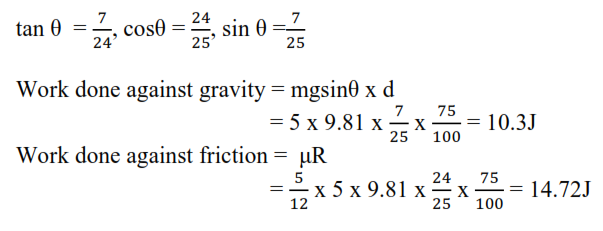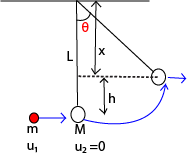
Work, power, energy (A-level physics)

Work, power, energy – (A-level)
Work is the product of force and distance moved. This distance must be in the direction of the force. Consider a body of mass, M, being pulled on a smooth horizontal table by a force F through a distance, s.

Work done = (F x s) joules
When a body is moved and the force acts at an angle θ to the horizontal as shown below. Assuming the flow is smooth

Work = Fcosθ joules
Work is a scalar quantity and its units are joules.
A joule is the work done when a force of 1N moves a distance of 1m in the direction of force from the point of application of force.
Example 1
A car of mass 1000kg moving on a rough horizontal surface is brought to rest in a distance of 10m by steady application of brakes. If the coefficient of sliding frictional force between the surface and the tyres is 0.4, calculate the work done by the frictional force.
Solution

Work done = f x s
But f = μR
R = 1000 x g
f = 0.4 x 1000 x 9.81 = 3934N
w = 3934 x 10 = 39,240J
Energy
This is the ability to do work. The S.I units of energy are joule. There are various forms of energy which include the following
- Mechanical energy
- Light energy
- Chemical energy
- Heat energy
- Tidal energy
- Magnetic energy
Mechanical energy
This type of energy is divided into two forms potential and kinetic energy.
Kinetic energy
This is the energy possessed by a body by virtue of its motion.
Suppose a constant force F, acts on the body of mass m, which is initially at rest on a smooth horizontal surface and moves distance, s.

The above expression is called the work energy theorem which states that the work done by an external force is equal to the change in kinetic energy of the body.
Potential energy
This is the energy possessed by a body by virtue of its position.
Potential energy is divided into
(i) Gravitation potential energy
This is the energy possessed by a body by virtue of its position in the gravitational field.
Consider a body of mass m raised from the ground at a position which is at a height, h, above the ground.
Work done against gravity = mgh and this gives the expression for gravitation potential energy.
(ii) Elastic potential energy
This is the energy possessed by a body when stretched or compressed.
Consider a material with elastic constant, k, which is stretched or compressed by amount, x.

Principle of conservation of mechanical energy
In any mechanical system, mechanical energy is conserved provided there is no dissipative force acting on the system
Dissipative forces are forces whereby work done against them cannot be recovered e.g. frictional force, air resistance, and viscous drag.
Proof of the principle of conservation of mechanical energy
Suppose, a body of mass, m, is projected vertically upwards with a speed, u, from the ground up to a height, h, and at that point the velocity of the body is v.

Solution
At A, potential energy = mg(0) = 0


From (i) and (ii), the mechanical energy at A is equal to mechanical energy at B, hence mechanical energy is conserved
Principle of conservation of energy
It state that energy can be changed from one form to another but is neither created nor destroyed.
Conservative force
This is one for which work done to the body from one point to another is independent of the path taken and only depends on initial and final positions of the body.
The work done to move a body round a closed path is zero and mechanical energy is conserved.
Examples include: gravitational force, electrostatic force, and elastic force.
Non conservative forces
This is one for which the work done against such force is moving the path taken
Work done to move a body around a closed path is not zero; mechanical energy is not conserved example include viscous drag, friction force, air resistance, etc.
Work done against gravity and friction
When a block is pulled at a uniform speed up the surface of a rough incline plane, work is done both against gravity and against the frictional force which is acting on the body due to the contact with the rough surface of the plane.
Example 1

Solution


Power
This is the rate of doing work or the rate of change of energy.

Thus, power is proportional to velocity
The S.I units of power are Js-1 or watts
A watt is the rate of transfer of energy at 1 joule per second.
Example 2
A car of mass 750kg stats from rest to a level road and is uniformly accelerated for 10 second until its speed is 18kmh-1. If the resistance to motion is 49N, find the power of the car 10 seconds after the start.
Solution

Example 3
A truck of mass 1500kg moves with uniform velocity of 5.0ms-1 up a straight track inclined at an angle 300 to the horizontal. The total frictional resistance to the motion of the truck is 580N. Calculate
(i) The power developed by the engine
(ii) If the engine of the track in (i) above cannot develop a power than 75kW. Calculate the maximum speed attained by the track.
Solution

ma = F – (mgsinθ +f)
since the velocity is uniform, a = 0
T = 1500gsin 30 + 580 = 7637.5N
But P = Fv = 5 x 7637.5 = 39687.5W

Example 4
A block of mass 6.0kg is projected with v=12ms-1 up a rough plane inclined 450 to the horizontal. If it travels 5m up the plane. Find the frictional force and the coefficient of friction.
Solution

K.E lost = P.E gained + Work done against friction

Example 5
A block of mass 3.95kg rests on a smooth horizontal surface. The wooden block is attached to light spring of force constant 100Nm-1, whose other end is fixed. A bullet of mass, 0.02kg is fired into the block embedded itself and the spring is compressed by 0.4m. Find the velocity of the bulled just before it hits the block.
Solution
By conservation of mechanical energy
K.E after collision = elastic potential energy

From the principle of conservation of momentum
m1u1 + m2u2 = v(m1 + m2)
0.02u1 + 3.98 x 0 = 2(0.02 + 3.98)
u1 = 400ms-1
therefore the velocity of the bullet before hitting the mass = 400ms-1.
Ballistic pendulum
Consider a bullet of mass, m, travelling with initial velocity, u, being fired horizontally into a stationary block of mass m which is suspended by light vertical string of length, L. If v is the common velocity of the block and bullet just after collision, the following can be noted.


Example 6
A bullet of mass 10g travelling horizontally at 100ms-1 embeds itself in a block of mass 990g suspended by a string so that is can swing vertically. Find the height through which the block can rise.


Example 7
(a) distinguish between conservative and non-conservative forces
(b) A bullet of mass 40g is fired from at 200ms-1 and hits a block of mass 2kg which is suspended by a light vertical string 2m long. If the bullet gets embedded in the wooded block; calculate
(i) the maximum angle the string makes with the vertical
(ii) State a factor on which the angle of swing depends.

By conservation of momentum
mu1 + Mu2= (m+ M)v
0.04x 200 + 2 x 0 = (0.04 + 2)v
v = 3.92ms-1


(ii) Factors on which the angle of swing depends
- speed of the bullet
- Mass of the block
- Length of the string
- Air resistance
Sponsored By The Science Foundation College
By Dr. Bbosa Science

Thanks for making complex ideas easy to understand. Electronics
I’m excited to see what’s next! Sports News
Discover the Top MBBS Colleges in Delhi, known for their world-class education and state-of-the-art facilities.
Learn how MBBS Fees Structure in Himachal Pradesh makes education affordable.
Get extra perks by sharing your Raja Luck Invite Code with friends.
Get business options with economical Server Rental in Chennai.
I love the adventure of anticipating properly on 82 lottery.
If you’re looking for a dependable way to extract audio from YouTube videos, Youtube To MP3 is the ideal service.
Follow every match in the **RCB IPL 2025 Schedule**, including Royal Challengers Bangalore’s components and opponents.